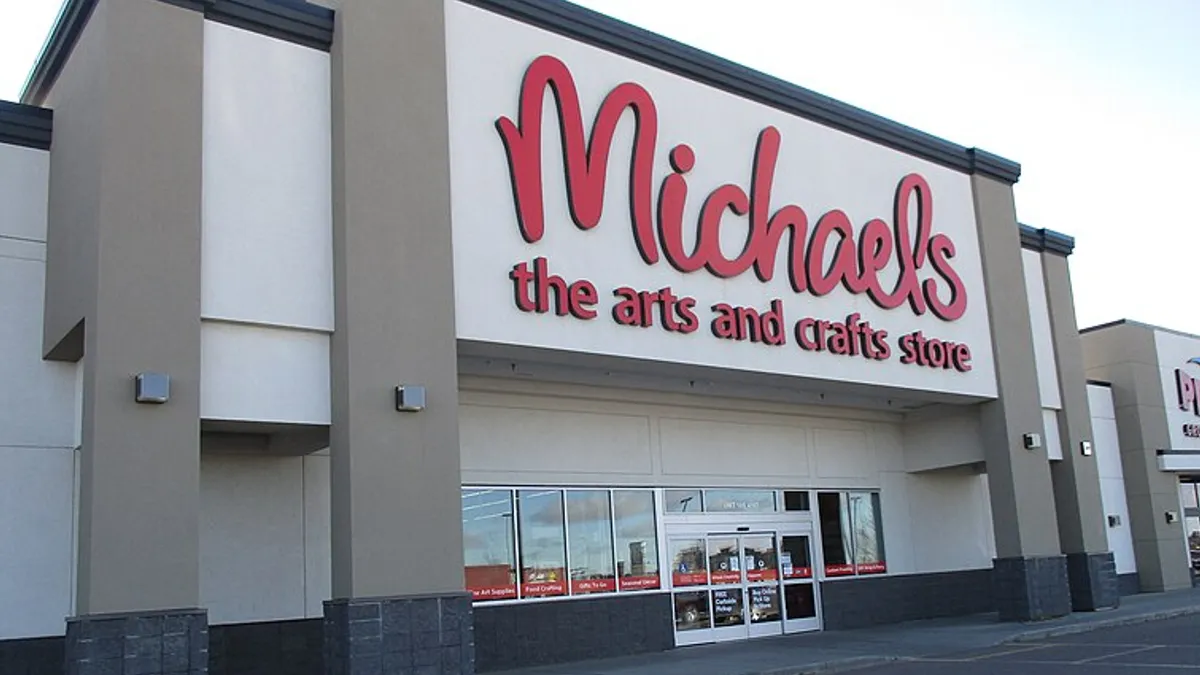An ecosystem of digitally-enabled stores has become one of the hallmarks of Nike's strategy, as the retailer pivots to a model that emphasizes its own stores and digital channels over wholesale.
Nike's neighborhood-centric, hyper-local Nike Live concept — a few years past its debut — is now an integral part of the company's store fleet, with plans for up to 200 small-format stores over time. The retailer's House of Innovation flagship format, which incorporates plenty of digital and personalization elements, has expanded to three locations since its launch: in New York, Shanghai and Paris (with Paris opening just last summer).
A few weeks before the Paris House of Innovation store opened, Nike extended its network of digital-focused storefronts yet again with a new concept: Nike Rise. That store, located in Guangzhou, China, was more of a test or, "what we called, 'the road to Rise,'" Daniel Heaf, vice president of Nike Direct, said in an interview.
Now, the retailer is launching a fuller expression of the Nike Rise concept in Seoul, South Korea, on Thursday. The Nike Rise format is the latest to join the store concept portfolio that also holds House of Innovation and Nike Live, and it takes learnings from both. It includes several data-driven features, and emphasizes a more localized approach in a similar way to Nike Live. But it's a 24,000-square-foot building — much closer to the size of a House of Innovation.
"This sits between those," Heaf said of how Nike Rise compares to the other two. "This is a bit of a bigger format door. It is made for the urban environment. It connects you, not just to your neighborhood, but actually to the city as a whole. And the store concept and experiences really represent the city as a whole."
Nike Rise, at least for now, also seems to sit somewhere between the two in terms of eventual store footprint. There "won't be that many" House of Innovation stores, Heaf said, while Nike Live sits on the other side of the spectrum, with a broad-based expansion ahead.
"We are bullish on physical retail. We are going to open hundreds more doors, and we look at it location by location," Heaf said of the future for Nike Rise stores. "Will there be more Rises? Absolutely. In other countries? Absolutely. But we sort of match the door to the consumer and to the location."
Local, but for more people
In some ways, Nike Rise is like a scaled-up version of Nike Live. While Nike Live is meant to be unique to a specific neighborhood, for example, the Melrose, Los Angeles, area where it launched, Nike Rise is meant to be unique to a specific city. As a result, the assortment is bigger than a Nike Live, as is the footprint of the store. But many similarly digital-enabled features, and an underlying ideology of connecting consumers to the store, can be found at Nike Rise.
One area of the store, dubbed the "huddle," allows shoppers to sign up for local events, including wellness discussions with experts, local runs or even workouts within the store itself. It also features a grab-and-go section with an assortment of nutrition and hydration products for pre- or post-workout snacking. A "broadcast booth" in the area allows the retailer to hold virtual training sessions and events in addition to in-person ones.
Similar experiential stores have been tried on by other players in the athletics space, including Lululemon. That retailer's experiential megastores hold things like yoga and HIIT workout studios, in addition to food offerings and local events. In fact, Lululemon's experiential Mall of America store, which opened in 2019, is about 4,000 square feet smaller than the Nike Rise store in Seoul.
Dick's, too, has recently been testing out multiple different store formats, one of which features a rock climbing wall, a turf field, batting cages and personal appointments with wellness experts. The retailer is also rolling out more experiential features to its existing fleet in an attempt to revamp those locations.
In its newest concept, while high on the experiential, Nike is also emphasizing the service element of the store. The Seoul location has a recycling and donation center that allows shoppers to drop off worn Nike footwear and — a first for the retailer — apparel, to be donated or recycled through partners in the community. The program recently launched in Europe as well. If clothes aren't ready to be donated yet, the store also offers repair services to help customers get more use out of their products.
Shoppers can sign up for one-on-one styling appointments (in person or virtual), and workshops that cover five pillars: movement, mindfulness, nutrition, sleep and recovery. Styling appointments can vary in purpose and span across the retailer's offerings.
"That could be performance or it could be for lifestyle," Heaf said. "It might be I want the full running, racing, get-up: the best pair of shorts, the best new Nike running apparel and the best new pair of trainers. And they would give me product advice on all of those dimensions. The same is true of lifestyle. If you're looking for an edgier, more streetwear look, a more look that represents the city, we'll be able to give you a styling session on that."
Personalized appointments give way to personalized apparel in another section of the store. Much like the retailer's House of Innovation, Nike Rise offers a slew of shopper customization options, including "hyper local embellishment kits," the ability to personalize a variety of Nike products, the option to customize a piece of apparel before it is made, a selection of local tees and local graphics for customization by Korean artist Jaehoon Choi.
In pursuing localization and community on a slightly larger scale, Nike is hoping to drive more loyalty from customers and, of course, drive more shoppers to become Nike members. Like many of Nike's digitally-enabled store concepts, Nike Rise offers a host of digital features that rely on the retailer's app, which in turn relies on customers being Nike members to be able to use it. It's part of the retailer's efforts to make its app incredibly useful to customers, thereby giving Nike itself more access to customer data.
"You don't have to be a member to shop in the Nike Rise store," Heaf said, "but it is unquestionably a better experience if you are because you can access all the services."
Digital, in different ways
In Nike Rise, there's the standard tech Nike has adopted for many of its stores: BOPIS, digital reservations of product and a place to make digital returns in stores. Then there's the nonstandard tech.
One of the core tech features in the store is an RFID-powered footwear comparison table that recognizes what shoes a customer places on the table and will provide product details and side-by-side comparisons of any two shoes in the store. The shopper doesn't have to bring over physical shoes to use the table: Customers can also search for products in the store to see product details on those.
That kind of technological interaction is part of the reason that the two existing Nike Rise stores are both in Asia. Seoul is "one of the world's most digitally-connected markets," according to Nike, and key countries in Asia tend to be ahead of the rest of the world in terms of interacting with digital services.
"The consumer's habits and how they interact with digital and physical is just that little bit more advanced," Heaf said. "So it's the perfect place for us to put in this really, really cutting edge retail concept. Secondly, and this is maybe not the traditional answer, we love the idea of sport in Korea, in Seoul. Yes, running and basketball, but also there are different expressions of sport that are important in Korea in dance and yoga. This store concept enables us to broaden our aperture for what Nike has traditionally thought of as sport, which is another good thing for us to kind of run through in the concept."
In the first test of this concept in Guangzhou, China, Heaf said Nike focused heavily on how to integrate mobile into physical retail, and what kind of in-person experiences could be offered in store based around the app. The success of those tests is what's allowing it to debut what Nike calls the "pinnacle expression" of the store format in Seoul: A location that marries the convenience of digital and connectivity with in-person interactions.
Outside of functional digital experiences, the store is filled with LED screens, which cover over 1,200 square feet of the location. That visual interaction starts at the very beginning of the store, with a tunnel of screens near the entrance that respond to movement and begin to light up when a consumer walks in.
One central "digital atrium screen" spans three stories and is focused on digital storytelling that's unique to Seoul. The experience is called "Sport Pulse," and it's the first Nike store to use the technology. At its core, the platform relies on data from Seoul to create real-time, localized stories and experiences. The data powering the experience comes from Nike's commerce apps and activity apps, as well as from local forecasts, sports and athletes.
Heaf refers to it as "an operating system for the store itself," but it also reflects what Nike's trying to do at scale: Use data to power personalization and build out its ecosystem of store concepts and apps. And, perhaps more importantly, make Nike customers worldwide feel that the retail giant truly knows them, and their specific city.
"It's pulling in data from our Nike Training Club and our Nike Run Club and it's showing, what are athletes in Seoul doing?" Heaf said. "And we're expressing that in heat maps, we're expressing that in miles run and we're expressing that in the shoes that they're wearing. It's sort of this data-led storytelling infused with all of our local brand imagery. It's giving you something that is almost real time — and personalized to the city."





















